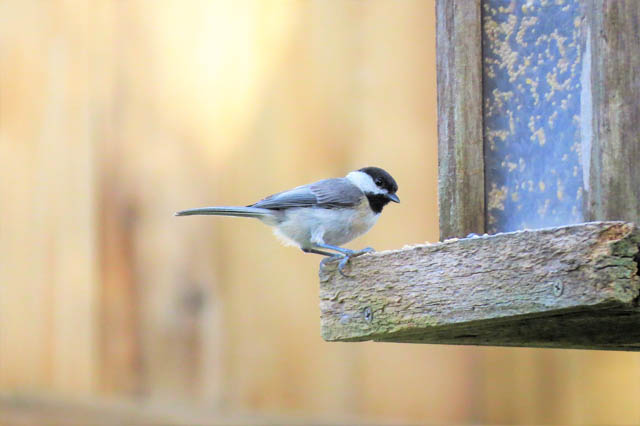Ohio is home to a diverse array of wild bird species, with some being seasonal visitors and others residing there throughout the year. In this piece, we will explore the top 26 backyard birds in Ohio and discover interesting facts about each of these species.
Moreover, I will guide you on how to attract these beautiful birds to your own yard, providing insights on ten different types of bird feeders that can be utilized for this purpose. Additionally, I will share some noteworthy birdwatching sites in Ohio, enabling you to immerse yourself in the joy of observing these avian creatures in their natural habitat.
Determining the exact number of bird species in Ohio, North America, or the United States is challenging. However, according to information from Wikipedia, Ohio boasts a minimum of 433 bird species. Various sources present conflicting data, stating that North America harbors either 2,059 or 914 species. While the accuracy of these figures may be uncertain, they do offer us a general understanding of the overall bird species count.
For the purposes of this article, we will focus on a selection of Ohio’s most renowned bird species.
26 COMMON BACKYARD BIRDS IN OHIO
Let’s delve into the following section where we’ll explore a collection of 26 backyard bird species found in Ohio. Among them, you’ll find both resident species that inhabit the state throughout the year, as well as migratory birds that make Ohio their temporary home. Although this list represents just a fraction of the diverse avian population in Ohio, these species are widely recognized and frequently observed in the state. So, without any delay, let’s begin our exploration of Ohio’s captivating backyard birds!
1. NORTHERN CARDINAL
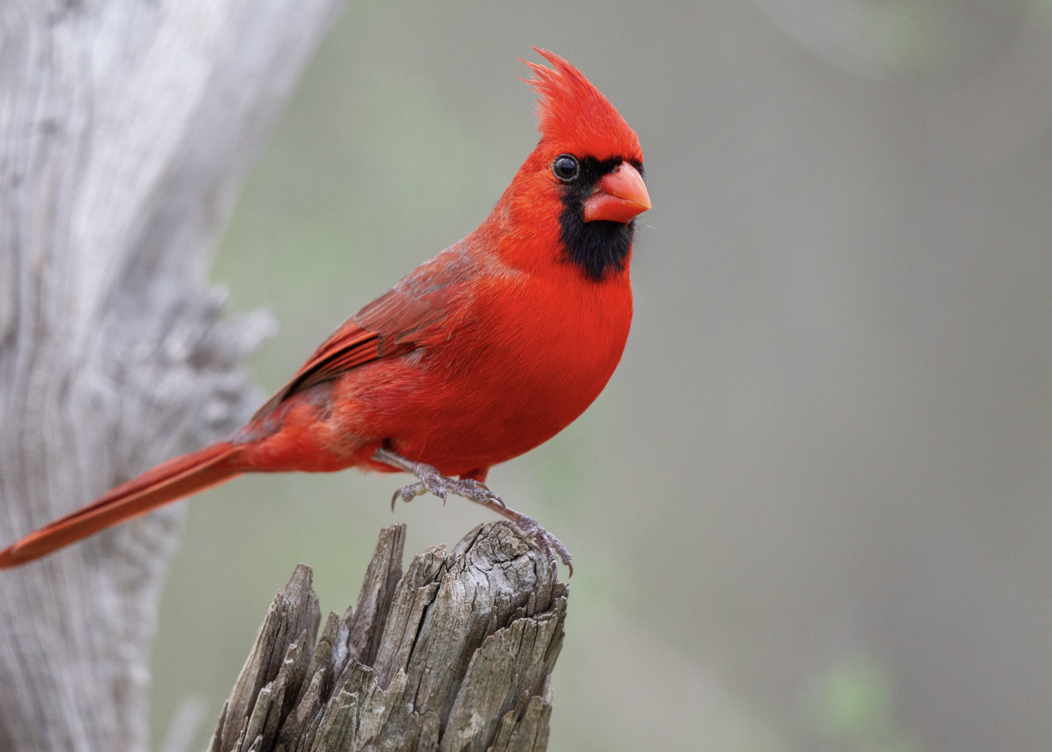
Species Name: Northern Cardinal (Cardinalis cardinalis)
Average Length: 8.3-9.1 inches
Average Weight: 1.5-1.7 ounces
Average Wingspan: 9.8-12.2 inches
The Northern Cardinal is a highly recognizable and frequently spotted backyard bird in North America. The males boast vibrant red plumage and a distinctive black mask, while the females exhibit a more subdued coloration with hints of pale brown and red. Both sexes have notable crests and reddish-orange beaks.
In Ohio, Northern Cardinals can be observed throughout the year, making them a permanent presence in the state’s avian population.
These beautiful birds readily visit various types of seed feeders, particularly those stocked with mixed seed blends and black sunflower seeds.
2. TUFTED TITMOUSE
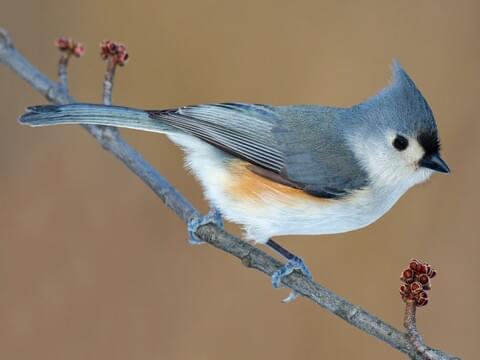
Species Name: Tufted Titmouse (Baeolophus bicolor)
Average Length: 5.5-6.3 inches
Average Weight: 0.6-0.9 ounces
Average Wingspan: 7.9-10.2 inches
Tufted Titmice are charming little birds commonly spotted in backyard settings and around feeders. They possess a distinctive small crest, reminiscent of a mohawk, which sets them apart from other avian species. The upper part of their bodies is silver-gray, while the underside tends to be lighter in coloration. Notably, they display a black patch just above their beaks.
The Tufted Titmouse can be found year-round throughout Ohio, making it a resident bird species in the state.
These delightful birds readily visit various seed feeders, where they eagerly consume a mix of black sunflower seeds.
3. CHICKADEES

Species Names: Black-Capped Chickadee (Poecile atricapillus), Carolina Chickadee (Poecile carolinensis)
Average Length: 4.7-5.9 inches (Black-Capped), 3.9-4.7 inches (Carolina)
Average Weight: 0.3-0.5 ounces (Black-Capped), 0.3-0.4 ounces (Carolina)
Average Wingspan: 6.3-8.3 inches (Black-Capped), 5.9-7.9 inches (Carolina)
Chickadees are small birds that are easily recognizable due to their black cap and bib. They have fluffy and light-colored underbodies, along with solid white cheeks. Their wings and backs exhibit shades of gray.
The eastern region is home to two types of Chickadees: the Black-Capped Chickadee and the Carolina Chickadee. While they may appear identical, their specific locations can help differentiate between them. In Ohio, both species of Chickadees can be found.
Throughout the year, both the Black-Capped and Carolina Chickadees reside in Ohio. The Carolina chickadees are present in all but the northernmost part of the state, while the black-capped chickadees can be found in the northern and eastern regions but not in the southwest.
Chickadees are regular visitors to most seed feeders, where they enjoy feasting on black sunflower seeds and mixed seed blends.
4. BLUE JAY

Species Name: Blue Jay (Cyanocitta cristata)
Average Length: 9.8-11.8 inches
Average Weight: 2.5-3.5 ounces
Average Wingspan: 13.4-16.9 inches
In North America, the Blue Jay is a prominent and widely recognized bird species. Known for their distinct blue crest, these birds exhibit a combination of white feathers on their underside and blue feathers on their upper body. They sport a striking black necklace-like ring around their necks. Their wings showcase a beautiful pattern of white, blue, and black bars. Both males and females share the same coloration.
Blue Jays are year-round residents of Ohio and are often spotted in backyards and near feeders, drawn to these areas.
Blue Jays are known to frequent platform feeders, peanut feeders, and feeders equipped with large perches. They eagerly consume black sunflower seeds, mixed seeds, and peanuts as part of their diet.
5. EASTERN BLUEBIRD
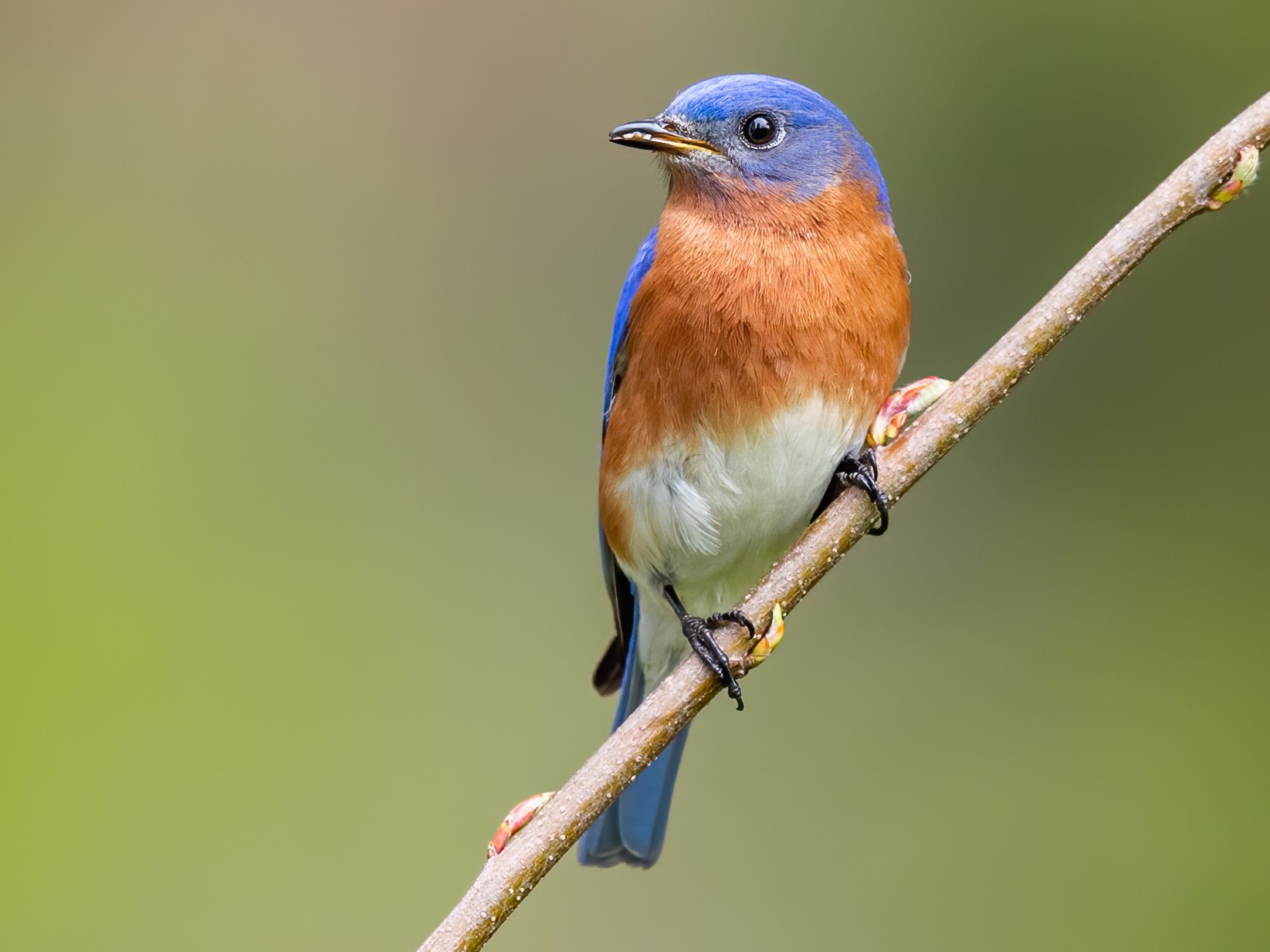
Species Name: Eastern Bluebird (Sialia sialis)
Average Length: 6.3-8.3 inches
Average Weight: 1.0-1.1 ounces
Average Wingspan: 9.8-12.6 inches
Bluebirds display a captivating combination of a blue upper body and a rusty reddish-orange belly, which is the inspiration behind their name. They are highly sought-after birds for birdhouses, making them the most popular residents of birdhouses across the United States. The bluebird house industry is thriving due to their popularity. While they may not be as commonly seen in backyards compared to feeders, bluebirds are still frequently encountered in residential areas. In fact, I had success attracting a mating pair of bluebirds using a birdhouse that I built and purchased on Amazon.
While bluebirds migrate in different regions of North America, they do not migrate in Ohio. Therefore, the Eastern Bluebird can be observed throughout the year in the state. For those interested in learning more about bluebirds in Ohio, a valuable resource to explore is the Ohio Bluebird Society, where you can discover additional information about these delightful birds.
Although bluebirds are not typically inclined to feed on seeds, you can entice them to visit your feeders by offering mealworms on a tray feeder or in a dish. This strategy can serve as an appealing and enticing food source for bluebirds, increasing the likelihood of their presence at your feeder.
6. WHITE-BREASTED NUTHATCH
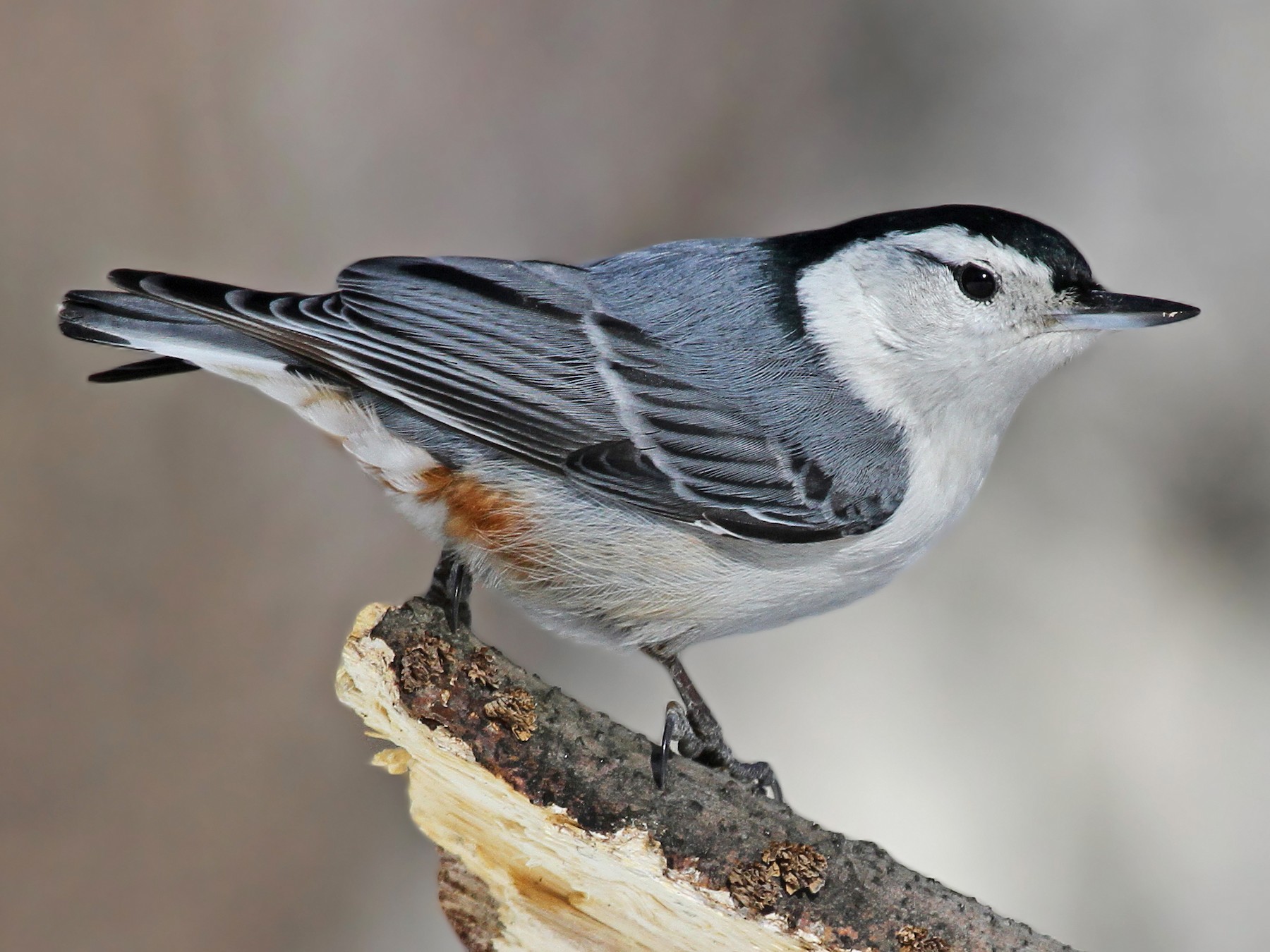
Species Name: White-breasted Nuthatch (Sitta carolinensis)
Average Length: 5.1-5.5 inches
Average Weight: 0.6-1.1 ounces
Average Wingspan: 7.9-10.6 inches
White-breasted Nuthatches are a frequent sight at feeders in many backyards within their habitat range. These birds derive their name from their behavior of tucking nuts and seeds beneath tree bark and then using their sharp beaks to “hatch” them out. They possess impressive climbing abilities, allowing them to ascend trees vertically with greater proficiency compared to many other bird species. White-breasted Nuthatches have striped black heads, with white plumage on either side and around their bellies. Their wings commonly display shades of gray and black.
Throughout the year, White-breasted Nuthatches can be found across Ohio, making them a resident bird species in the state.
Most seed feeders tend to attract nuthatches, and you can entice them by offering black sunflower seeds, peanuts, or suet. These food options are particularly appealing to nuthatches, encouraging their visitation and providing them with nourishment.
7. AMERICAN ROBIN
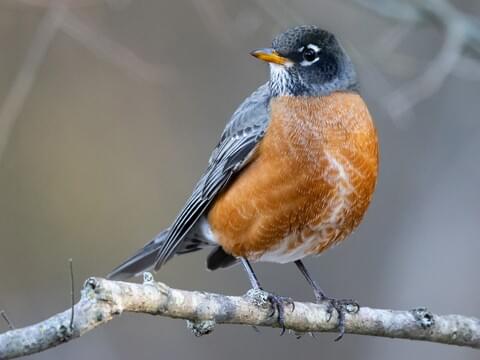
Species Name: American Robin (Turdus migratorius)
Average Length: 7.9-11.0 inches
Average Weight: 2.7-3.0 ounces
Average Wingspan: 12.2-15.8 inches
Robins are a familiar sight in backyards, often seen hopping on the grass as they search for worms and other invertebrates to consume. While they are commonly associated with warmer months, during winter, they tend to retreat to wooded areas, creating the impression that they have migrated out of the state. However, they return to more visible locations as spring arrives. Robins primarily rely on a diet of worms and invertebrates, rarely consuming seeds, although they may occasionally visit bird feeders. Their vibrant crimson bellies and yellow beaks make them easily recognizable.
In Ohio, robins can be found throughout the year, making them a year-round presence in the state.
To attract American Robins to bird feeders, providing mealworms, native fruit-bearing plants, or a bird bath can prove enticing, as these elements align with their natural preferences. Since robins are not frequent visitors to feeders, creating a hospitable environment that mimics their natural food sources and watering spots is key to inviting their presence.
8. MOURNING DOVE
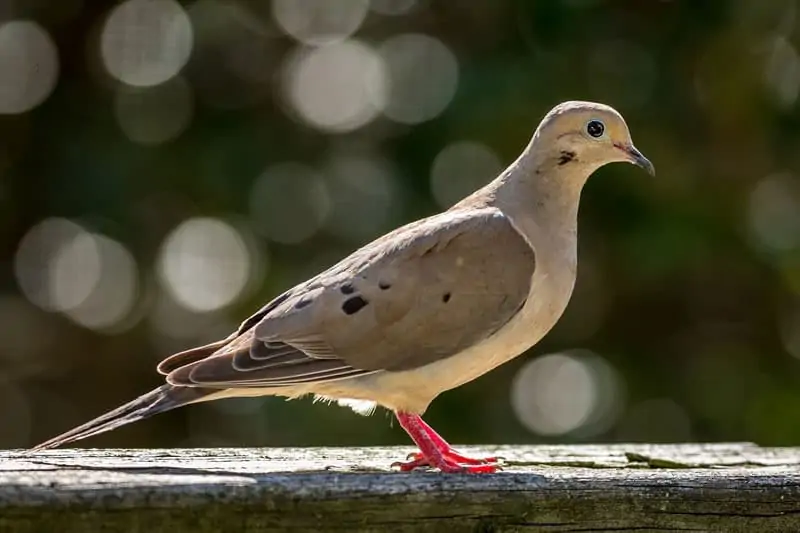
Species Name: Mourning Dove (Zenaida macroura)
Average Length: 9.1-13.4 inches
Average Weight: 3.0-6.0 ounces
Average Wingspan: 17.7 inches
Mourning Doves are small birds that can often be observed in gardens, perched on power lines, or gathered in clusters within trees, similar to robins. While they may occasionally visit food tray feeders, they are more commonly seen foraging on the ground. Most mourning doves have gray plumage, with black markings on their upper parts and a pale peachy color on their undersides.
Mourning Doves are present in Ohio throughout the year, making them a permanent fixture in the state.
Although dove feeders are common, Mourning Doves have a preference for searching the ground for fallen seeds. To attract them, you can scatter some seeds on the ground or try using a ground feeder with a mixed seed blend. This method mimics their natural foraging behavior and increases the likelihood of their presence in your backyard.
9. EUROPEAN STARLING

Species Name: European Starling (Sturnus vulgaris)
Average Length: 7.9-9.1 inches
Average Weight: 2.1-3.4 ounces
Average Wingspan: 12.2-15.8 inches
European Starlings were introduced to the United States in the 1890s when a hundred of them were released in New York. Since then, they have rapidly spread across the country, including Ohio. However, their presence has been accompanied by some concerns. Starlings have a tendency to dominate feeders, disrupting other birds’ nests and causing harm to their young. They possess yellow beaks and feet and generally exhibit a dark plumage with white speckles on their backs and wings. Under certain lighting conditions, starlings can display a striking iridescent coloration, ranging from purple to green.
It’s worth noting that European Starlings are considered an invasive species, and their impact on native bird populations is a concern. Therefore, it is not recommended to actively attract them to your feeders, as they are likely to appear on their own.
European Starlings are present in every state of the lower 48, including Ohio. These adaptable birds have a broad diet and will consume a wide range of food sources. While it is important to appreciate the beauty of nature’s diversity, it is also crucial to prioritize the well-being of native bird species and ecosystems.
10. AMERICAN GOLDFINCH
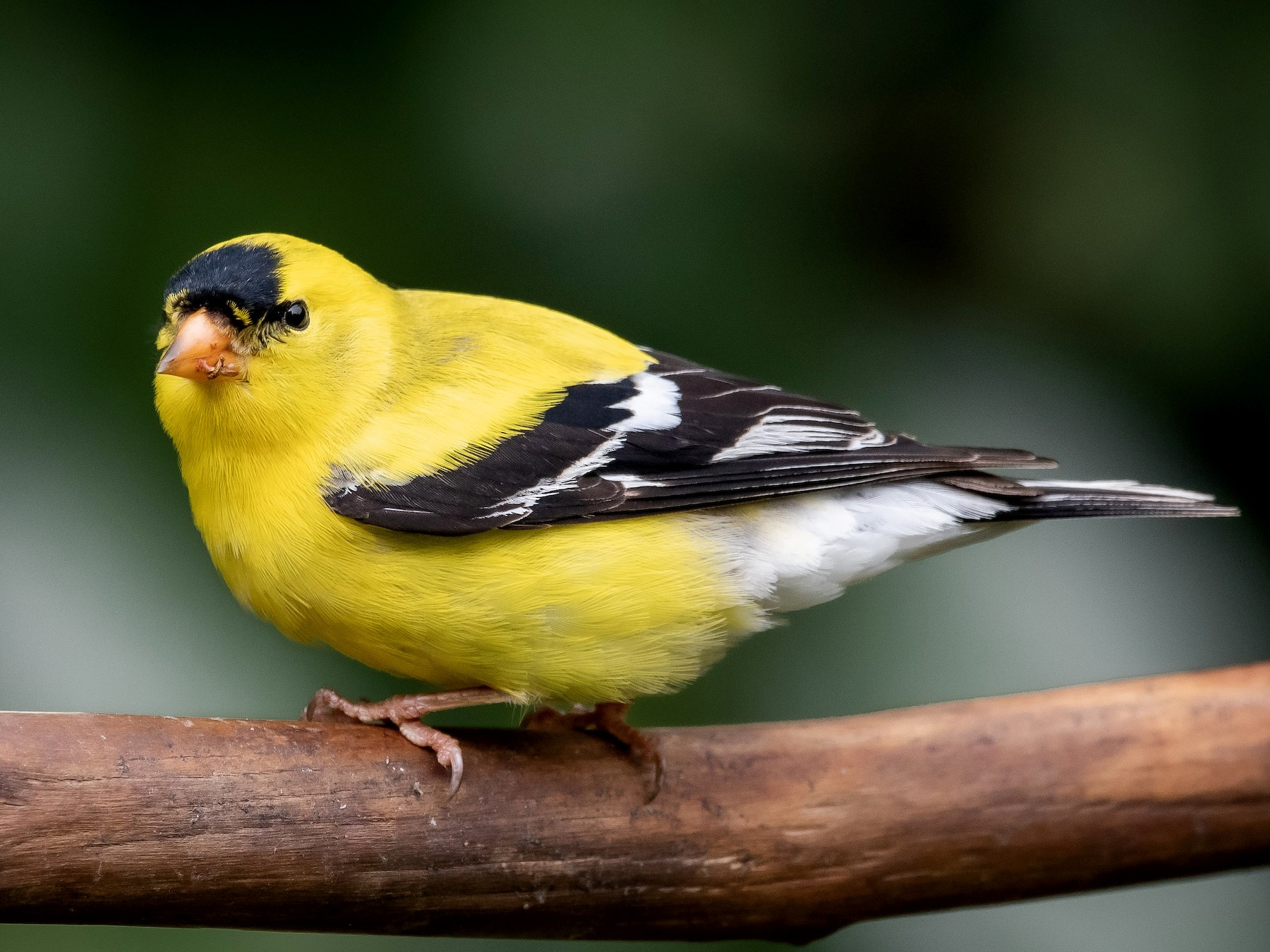
Species Name: American Goldfinch (Spinus tristis)
Average Length: 4.3-5.1 inches
Average Weight: 0.4-0.7 ounces
Average Wingspan: 7.5-8.7 inches
American Goldfinches hold a special place among my favorite birds to observe at feeders, particularly during the spring and summer when their bright yellow feathers are on full display. These charming birds exhibit black-tipped wings and are predominantly yellow or “gold” during this time. The males also sport a distinctive black hat-like marking on their heads. However, during winter, they molt and transition to a more subdued brownish or olive color, losing their vibrant hues. Nevertheless, the black wings and finch-like beaks always help distinguish them from other bird species.
American Goldfinches can be found year-round throughout Ohio, making them a constant presence in the state.
While sunflower chips can be enticing for attracting goldfinches, the most effective way to attract them is by providing thistle feeders. Goldfinches have a particular affinity for thistle or nyjer seeds, and offering them in specialized thistle feeders increases the likelihood of attracting these delightful birds to your yard.
11. HOUSE FINCH
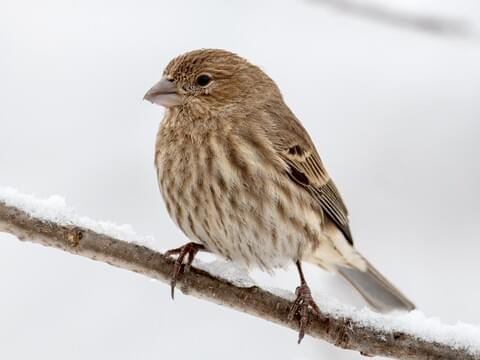
Species Name: House Finch (Haemorhous mexicanus)
Average Length: 5.1-5.5 inches
Average Weight: 0.6-0.9 ounces
Average Wingspan: 7.9-9.8 inches
In Ohio, the House Finch is another beloved backyard bird species. While they are considered invasive in the state, they do not pose the same issues as House Sparrows and are not universally disliked. House Finches have a tendency to gather in large flocks and can mob your feeders if you successfully attract them, which is relatively easy to accomplish. Female House Finches display an overall brown coloration, while males exhibit streaked brown feathers with hints of red on their head and chest.
House Finches can be observed throughout Ohio at any time of the year, making them a constant presence in the state.
Like other finches, House Finches primarily feed on thistle seeds. While Goldfinches tend to be more commonly seen at seed feeders, incorporating some black sunflower seeds into your offerings can also attract House Finches. This variety in food options increases the chances of enticing these delightful birds to visit your feeders.
12. HOUSE SPARROW
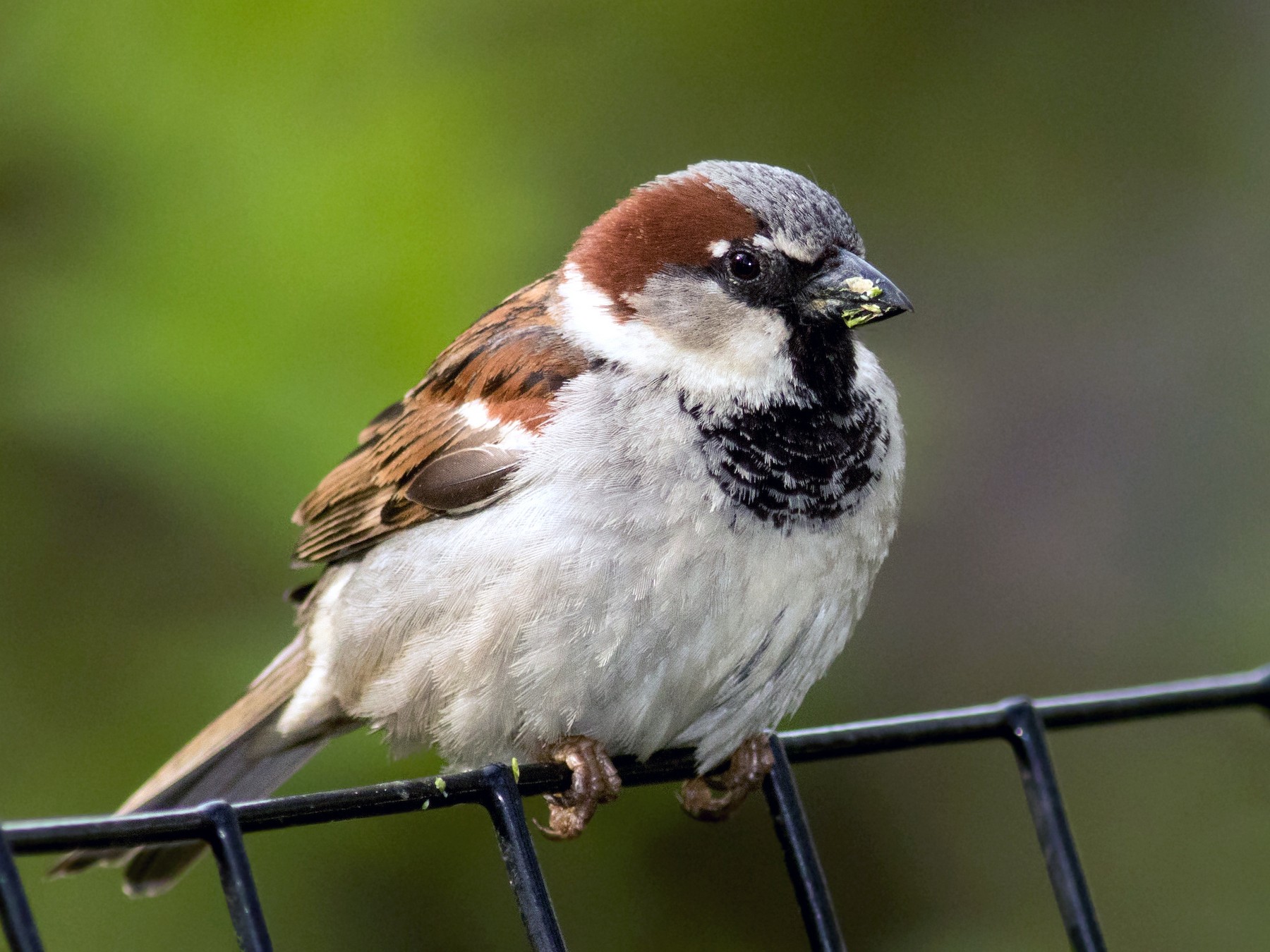
Species Name: House Sparrow (Passer domesticus)
Average Length: 5.9-6.7 inches
Average Weight: 0.9-1.1 ounces
Average Wingspan: 7.5-9.8 inches
House Sparrows are the only other wild bird species found in the United States alongside European Starlings, and they are often regarded as pests. Unlike starlings, it is legal to trap and eliminate House Sparrows, along with other designated nuisance bird species. Introduced to New York in the 1800s, House Sparrows have since spread across the entire United States. These birds primarily display a brown hue on their wings and buffy chests, accompanied by streaks of black and brown. They generally exhibit hostile behavior towards other birds, especially when defending their nests.
House Sparrows can be found year-round in all regions of Ohio, establishing themselves as permanent residents in the state.
It’s important to note that House Sparrows, like European Starlings, are considered invasive species and pose a threat to native wildlife. They are opportunistic feeders and will consume various food sources. Due to their invasive nature and potential negative impact on indigenous species, managing House Sparrow populations is generally advised.
13. RED-WINGED BLACKBIRD

Species Name: Red-winged Blackbird (Agelaius phoeniceus)
Average Length: 6.7-9.1 inches
Average Weight: 1.1-2.7 ounces
Average Wingspan: 12.2-15.8 inches
Male Red-winged Blackbirds are one of the most commonly encountered bird species in North America. They are easily distinguishable by their dark bodies and vibrant crimson and yellow “shoulders,” which are actually colorful patches on their wings. In contrast, females of this species display a predominantly brown coloration with light streaks, presenting a distinct appearance. Male Red-winged Blackbirds are known to be polygynous, often having multiple female mates, with some males having up to 15 different partners.
Red-winged Blackbirds are year-round residents of Ohio, making them a permanent presence in the state.
Red-winged Blackbirds can be attracted to various types of feeders, as they are versatile feeders that consume both seeds and suet. Offering a variety of food options can entice these birds to visit your feeders and provide them with a reliable food source.
14. BROWN-HEADED COWBIRD

Species Name: Brown-headed Cowbird (Molothrus ater)
Average Length: 7.5 – 8.7 inches
Average Weight: 1.5 – 1.8 ounces
Average Wingspan: 12.6 – 15.0 inches
Brown-headed Cowbirds, along with other types of blackbirds, are often categorized under the umbrella term of “blackbirds.” This classification is not only due to the black coloration of the males but also because they tend to gather in large flocks, sometimes alongside other blackbird species. Male Brown-headed Cowbirds feature an iridescent black body, while their heads exhibit a dark brown hue. Females, on the other hand, have a lighter brown overall coloration.
Regrettably, cowbirds have a unique reproductive strategy that negatively impacts other bird species. They lay their eggs in the nests of other birds, reducing the numbers of the host species. Cowbirds may sneak into nests and deposit their eggs alongside those of the host, or they may push out other eggs to make space for their own. Many birds recognize the imposter eggs and reject them, treating the chicks as if they were their own.
Ohio serves as a year-round home for cowbirds, as they are present throughout the year in the state.
Brown-headed Cowbirds are frequent visitors to feeders and can be observed in large numbers. They primarily consume mixed seed as their preferred food source. Providing a variety of mixed seeds can help accommodate their feeding preferences and attract them to your feeders.
15. SONG SPARROW
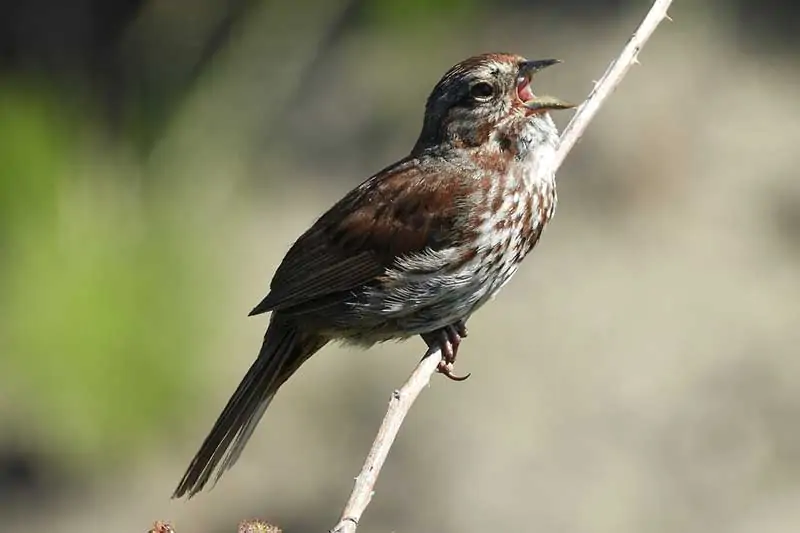
Species Name: Song Sparrow (Melospiza melodia)
Average Length: 4.7-6.7 inches
Average Weight: 0.4-1.9 ounces
Average Wingspan: 7.1-9.4 inches
Song Sparrows exhibit predominantly brown backs and wings, with a white breast adorned with prominent brown streaks. The plumage of Song Sparrows can vary slightly across different regions, but they are commonly encountered throughout most of North America. Male Song Sparrows utilize their melodious song not only to attract females but also to defend their territory from intruders.
While Song Sparrows can be found across the entire United States, they are particularly prevalent in Ohio.
Song Sparrows occasionally visit bird feeders, where they consume a variety of food sources, including mixed seeds and sunflower seeds. Providing these offerings can increase the likelihood of attracting Song Sparrows to your feeders, allowing you to observe and appreciate their beautiful presence.
16. RED-BELLIED WOODPECKER

Species Name: Red-bellied Woodpecker (Melanerpes carolinus)
Average Length: 9.4 inches
Average Weight: 2.0-3.2 ounces
Average Wingspan: 13.0-16.5 inches
Red-bellied Woodpeckers are medium-sized woodpeckers commonly observed in the eastern United States, often frequenting feeders and backyards. Despite their name, the most noticeable feature is the vibrant red stripe that runs down the back of their heads. Their “belly” region, however, typically doesn’t display the prominent red coloration and is usually concealed. The white breast of these woodpeckers is complemented by black and white barring on their wings, making them easily recognizable.
Red-bellied Woodpeckers are year-round residents in Ohio, establishing their presence throughout the entire year.
While Red-bellied Woodpeckers may occasionally visit seed feeders, especially if peanuts are provided, the most effective way to attract them is through a suet feeder. These woodpeckers have a particular affinity for suet, and offering it as a food source can entice them to visit your feeder. Enjoy the sight of these fascinating birds as they indulge in their preferred treats.
17. DOWNY WOODPECKER

Species Name: Downy Woodpecker (Picoides pubescens)
Average Length: 5.5-6.7 inches
Average Weight: 0.7-1.0 ounce
Average Wingspan: 9.8-11.8 inches
Downy Woodpeckers are highly fond of bird feeders and are commonly encountered in backyard settings. They often catch my attention as one of the first birds to visit a new feeder. Despite being the smallest woodpeckers in North America, they possess distinct characteristics that set them apart. Notably, the males feature a red mark on the back of their heads, while females lack this red marking. Their striking appearance includes a combination of a completely white underbody, black wings with white spots, and black and white striped heads. Although they resemble the Hairy Woodpecker, Downy Woodpeckers are smaller in size.
The Downy Woodpecker can be observed throughout the year across Ohio, making them a resident bird species in the state.
Downy Woodpeckers are commonly found at various types of bird feeders, including hanging cages. Providing them with a range of food options is recommended, such as mixed seeds, black sunflower seeds, and suet. This diverse selection will attract these delightful woodpeckers to your feeders, allowing you to enjoy their presence and unique behaviors.
18. COMMON GRACKLE
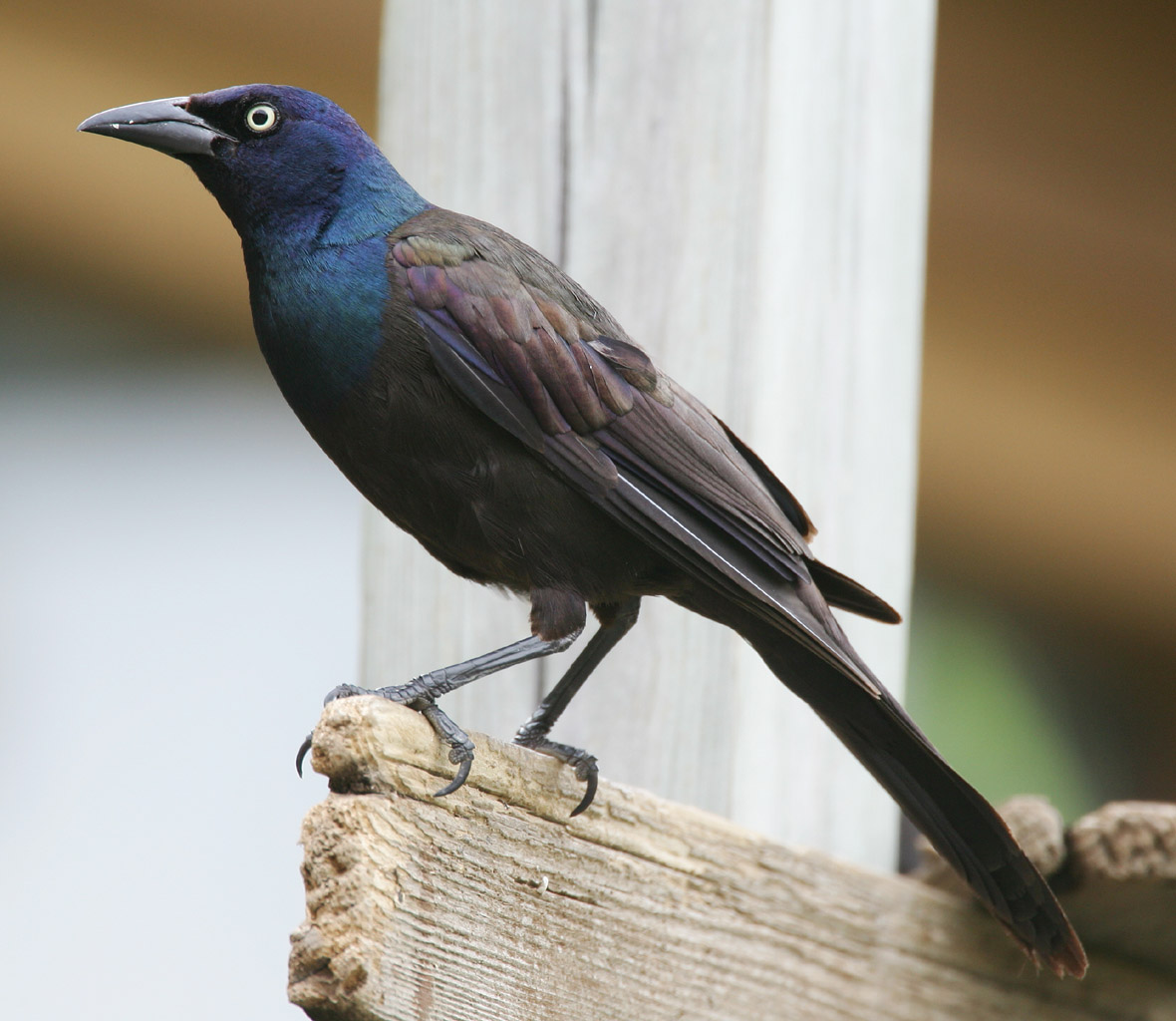
Species Name: Common Grackle (Quiscalus quiscula)
Average Length: 11.0-13.4 inches
Average Weight: 2.6-5.0 ounces
Average Wingspan: 14.2-18.1 inches
Grackles possess a unique charm, showcasing their iridescent feathers that can be truly captivating under the right lighting conditions. Although they are sometimes categorized as bully birds, similar to starlings, their appearance is striking. Typically displaying a black plumage, their feathers can exhibit hints of blue, green, brown, and purple when illuminated by bright light. Grackles are known to roost alongside other types of blackbirds, forming massive flocks that can number in the millions. Their sleek, elongated bodies, solid colors, and distinctive yellow-ringed eyes make them easily recognizable.
Grackles are year-round residents in Ohio, making the state their permanent home.
While grackles are often referred to as pests, it is primarily due to their foraging behavior and adaptability. They are opportunistic eaters, consuming a wide range of food sources, and will readily consume almost anything they come across. This behavior, while potentially disruptive, is a testament to their survival skills and adaptability as a species.
19. HAIRY WOODPECKER

Species Name: Hairy Woodpecker (Leuconotopicus villosus)
Average Length: 7.1-10.2 inches
Average Weight: 1.4-3.4 ounces
Average Wingspan: 13.0-16.1 inches
Hairy Woodpeckers closely resemble Downy Woodpeckers in appearance, with only a few key distinctions to set them apart. These differences primarily lie in their larger size and a few other important characteristics. Their patterns are nearly identical, and both species can be found in various locations across the nation. However, I have noticed that Hairy Woodpeckers are not as regular visitors to bird feeders compared to Downy Woodpeckers.
Hairy Woodpeckers can be observed throughout the year in Ohio, establishing their presence as year-round residents.
Unlike Downy Woodpeckers, Hairy Woodpeckers are known to consume suet and seed feeders. Their feeding habits include a broader range of food options, making suet and seed feeders an effective way to attract these woodpeckers to your backyard. Providing a suitable feeding station can increase the chances of enjoying the presence of Hairy Woodpeckers and observing their unique behaviors.
20. DARK-EYED JUNCO
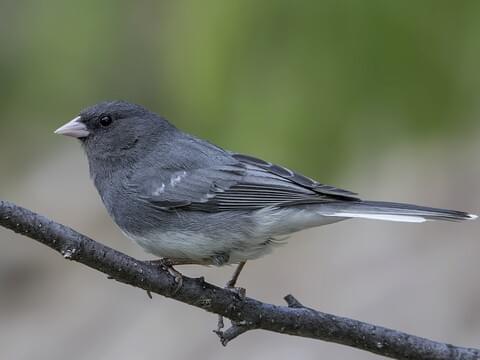
Species Name: Dark-eyed Junco (Junco hyemalis)
Average Length: 5.5-6.3 inches
Average Weight: 0.6-1.1 ounces
Average Wingspan: 7.1-9.8 inches
Dark-eyed Juncos are often regarded as winter birds by people in the United States, as they spend their summers in Canada. These charming birds showcase a light pink beak and possess blackish gray heads, with an overall dark slate-gray coloration on their upper parts. However, their lower half exhibits a lighter grayish-white hue. Female and immature Juncos may display a more buffy brown coloration. These birds are commonly found in wooded areas and forests, where they can be observed hopping around on the ground.
In Ohio, Dark-eyed Juncos are primarily present during the winter season. However, there may be a few isolated areas around Cleveland and Lake Erie where they remain year-round.
Dark-eyed Juncos occasionally visit feeders, although they generally prefer to forage on the ground beneath the feeders. They have a preference for a combination of seeds and can often be seen pecking at the scattered seeds on the ground. Providing a suitable feeding area with a variety of seeds can attract these delightful Juncos to your yard and provide them with a reliable food source.
21. BALTIMORE ORIOLE

Species Name: Baltimore Oriole (Icterus galbula)
Average Length: 6.7-7.5 inches
Average Weight: 1.1-1.4 ounces
Average Wingspan: 9.1-11.8 inches
Orioles are known for their preference for fruits and dark berries. Among them, the Baltimore Orioles stand out. If your yard features native fruit-bearing trees and plants, you have a good chance of attracting these vibrant birds. Adult male Baltimore Orioles showcase a striking appearance, with their entire breast and underbody adorned in brilliant orange, complemented by a dark hood that covers their entire head. They possess black backs with distinctive white wing stripes. Their rump and tail feathers also exhibit an enchanting shade of orange. In comparison, females display a more subdued yellowish-orange coloration.
Baltimore Orioles make their presence known during the breeding season, which is when they appear in most regions of the United States, including Ohio. Keep a lookout for them during the spring and early summer.
To entice Baltimore Orioles to visit your yard, offering sweet treats is highly effective. Setting up an oriole feeder with nectar or other sugary solutions can attract these beautiful birds. Providing a source of sweetness will increase your chances of enjoying the presence of Baltimore Orioles and witnessing their graceful presence in your surroundings.
22. RUBY-THROATED HUMMINGBIRD
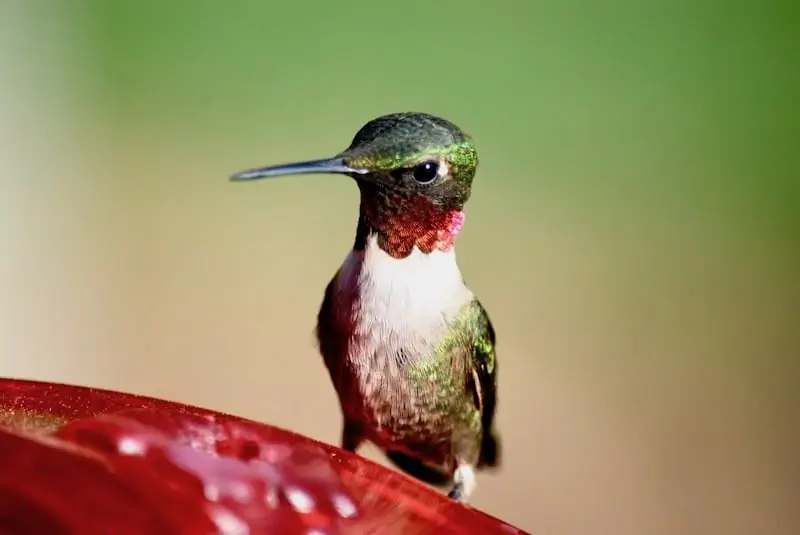
Species Name: Ruby-throated Hummingbird (Archilochus colubris)
Average Length: 2.8-3.5 inches
Average Weight: 0.1-0.2 ounces
Average Wingspan: 3.1-4.3 inches
Ruby-throated Hummingbirds dominate the hummingbird population in the United States, primarily inhabiting the eastern regions. They are, in fact, the sole hummingbird species found in the eastern part of the country. These magnificent birds derive their name from the vibrant crimson coloration of the males’ necks. The back, wings, and head of Ruby-throated Hummingbirds shimmer in a dazzling emerald green, while their underparts display a pristine white. Females, on the other hand, lack the striking red throat feathers.
Ruby-throated Hummingbirds are the most prevalent hummingbirds in Ohio, with occasional sightings of rare vagrant species. They can be encountered throughout the state from spring to fall, making appearances in all areas.
To attract Ruby-throated Hummingbirds to your backyard, setting up nectar feeders is highly recommended. These tiny birds have a strong affinity for nectar and are highly likely to visit your yard if you provide a reliable nectar source. Keep an eye out for their arrival, which typically occurs in April or May, and delight in observing the enchanting presence of Ruby-throated Hummingbirds as they flutter and sip from the nectar feeders.
23. NORTHERN MOCKINGBIRD
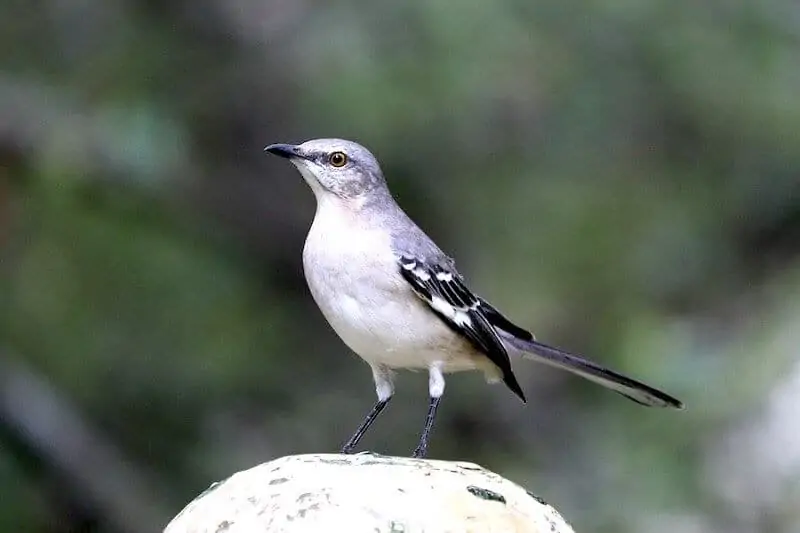
Species Name: Northern Mockingbird (Mimus polyglottos)
Average Length: 8.3-10.2 inches
Average Weight: 1.6-2.0 ounces
Average Wingspan: 12.2-13.8 inches
Mockingbirds have gained their name from their remarkable ability to mimic the sounds of other bird species. Male mockingbirds, in particular, have been known to learn an impressive repertoire of up to 200 different songs throughout their lives. These medium-sized birds possess distinctive features, including their rather long tail feathers, which help set them apart from other species. Their large white wing stripes make them highly visible during flight, making them easily distinguishable. Mockingbirds are frequently spotted perched on high bushes, poles, or power lines. They are notorious for fiercely defending their nests, displaying aggressive behaviors towards anything or anyone that comes too close, including cats and even humans. They may dive-bomb and assertively ward off any perceived threats.
With the exception of the far northwestern corner, where they may only be present during the breeding season, Northern Mockingbirds can be found year-round throughout the state of Ohio.
While Northern Mockingbirds are common in backyards, they do not typically consume birdseed. However, you can attract them to your yard using other techniques. Planting fruit-bearing shrubs, installing insect-supporting plants, or providing a bird bath can serve as enticing features to attract these fascinating birds to your outdoor space. Their melodious songs and impressive mimicry make Northern Mockingbirds a delightful addition to any birdwatching experience.
24. GRAY CATBIRD
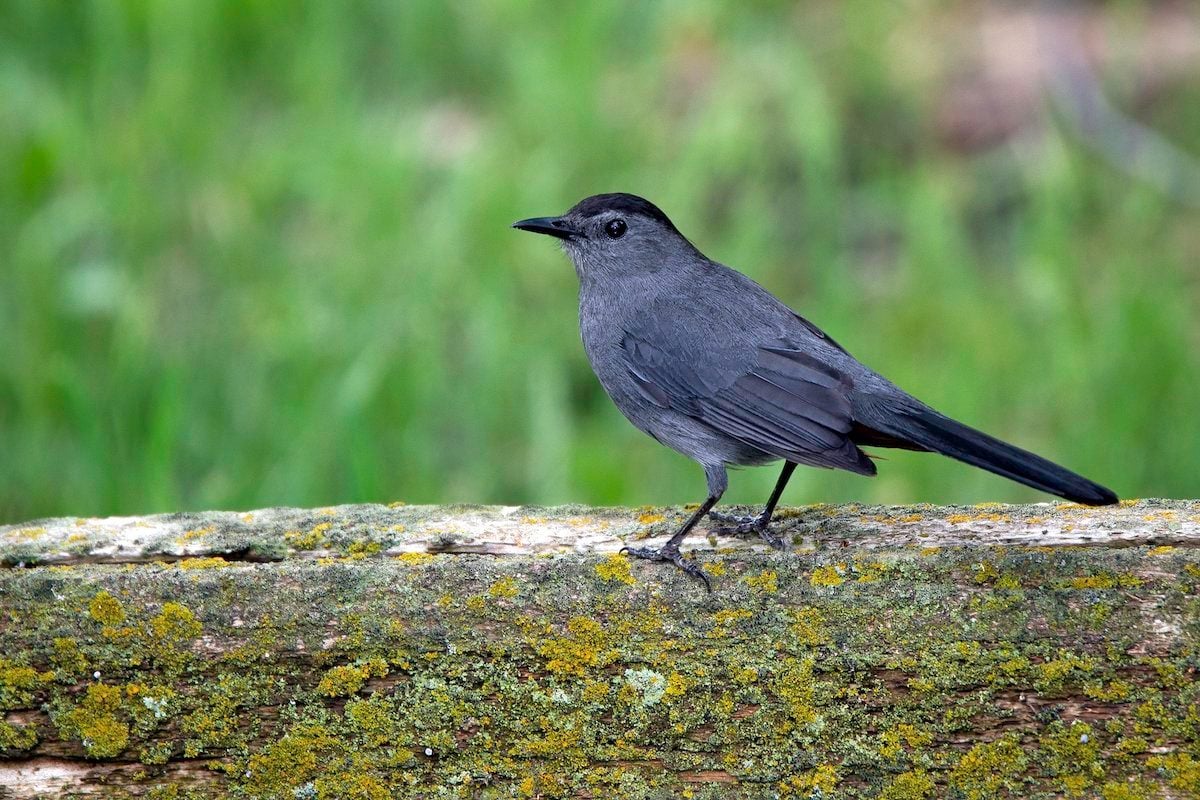
Species Name: Gray Catbird (Dumetella carolinensis)
Average Length: 8.3-9.4 inches
Average Weight: 0.8-2.0 ounces
Average Wingspan: 8.7-11.8 inches
Gray Catbirds are easily distinguishable by their blackish gray wings and long tails. These birds exhibit a dark slate gray coloration, with black caps adorning the tops of their heads. They are predominantly fruit eaters, making native fruit-bearing trees and bushes particularly enticing to them. The distinctive feature of their vocalizations is that they resemble the meowing sounds of a cat, which gives them their name “catbird.”
Gray Catbirds are seasonal residents in Ohio and various parts of the United States, primarily during the spring and summer seasons.
To attract Gray Catbirds, offering a variety of fruits, berries, and other sweet food items can be effective. However, it is important to note that they prefer to forage on the ground or in bushes for their food. Providing a suitable habitat with natural food sources, along with creating a welcoming environment with suitable vegetation and water sources, can increase the likelihood of attracting these delightful birds to your yard.
25. NORTHERN FLICKER

Species Name: Northern Flicker (Colaptes auratus)
Average Length: 11.0-12.2 inches
Average Weight: 3.9-5.6 ounces
Average Wingspan: 16.5-20.1 inches
Northern Flickers are medium to large-sized woodpeckers commonly seen in backyards across the United States, although they are not as frequent visitors to feeders. In my opinion, they are one of the most stunning birds in North America. Unlike other woodpeckers, Flickers have a unique foraging behavior where they prefer to search for insects on the ground rather than in trees. Their distinct features include black markings on their bellies, a solid black bib, a red patch on the back of their necks, and barred black and gray wings. In Ohio, the “yellow-shafted” variety of Northern Flickers can be found, characterized by their vibrant yellow feathers on the undersides of their wings.
Northern Flickers are year-round residents in Ohio, meaning they can be observed throughout the year.
While Northern Flickers may occasionally visit suet feeders, they are not as frequent as other woodpecker species. If you have leaf mounds or natural areas in your yard, you may have the opportunity to witness them searching for insects by digging around. Providing a suitable habitat with trees and open spaces can attract these remarkable birds, allowing you to appreciate their beauty and unique foraging behaviors.
26. WHITE-THROATED SPARROW
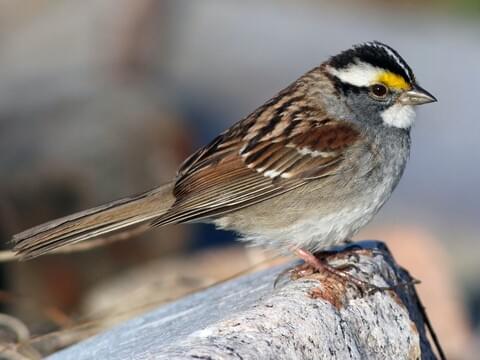
Species Name: White-throated Sparrow (Zonotrichia albicollis)
Average Length: 6.3-7.1 inches
Average Weight: 0.8-1.1 ounces
Average Wingspan: 7.9-9.1 inches
White-throated Sparrows are widespread throughout much of the United States. They embark on a migration to Canada for breeding during the summer season after spending the winter months there. These sparrows can be easily identified by their distinctive facial pattern, featuring bold black and white stripes with yellow spots between the eyes. Their white throat patch sets them apart from other sparrows and aids in their identification. Female White-throated Sparrows often construct nests in concealed locations within dense shrubs and vegetation, occasionally on or slightly above the ground.
White-throated Sparrows can be observed in various regions of Ohio during the winter months, although their presence is primarily limited to this season.
HOW TO ATTRACT BIRDS TO YOUR YARD
Here are 5 effective tips to attract birds to your backyard:
- Set up Bird Feeders: Bird feeders are a simple and effective way to attract birds. Choose from various types such as tube feeders, hopper feeders, platform feeders, or window feeders. Use black sunflower seeds or mixed birdseed as feed. Squirrel-proof feeders are also available for added convenience.
- Provide a Water Source: Include a water feature in your yard, such as a birdbath or a solar fountain. Birds need water not only for drinking but also for bathing. Moving water, like that from a fountain, can be particularly attractive to birds.
- Install Birdhouses: Place birdhouses in suitable locations and during the right time of year to attract nesting birds. Eastern Bluebirds are popular birds that readily use birdhouses. Provide a safe and inviting environment for birds to establish their homes.
- Create Shelter: Ensure that your yard has trees, shrubs, and bushes where birds can seek shelter and escape potential dangers. The presence of natural cover will help protect birds from predators. If your yard lacks mature trees, consider adding landscaping elements that offer safety and refuge.
- Plant Native Species: Include native plants in your yard that produce nuts, berries, and seeds, as these attract a wide range of bird species. Native plants also support insects like caterpillars, which are an important food source for nesting birds. Avoid invasive and non-native plants that may disrupt the ecosystem.
In addition, here are 10 popular types of bird feeders commonly found in yards:
- Hopper feeder
- Platform feeder
- Tube feeder
- Suet feeder
- Window feeder
- Thistle feeder
- Ground feeder
- Oriole feeder
- Hummingbird feeder
- Peanut feeder
Each feeder type serves different bird species and their feeding preferences. By offering a variety of feeders and suitable food, you can attract a diverse range of birds to your backyard.
BIRD WATCHING IN OHIO
For bird enthusiasts looking to explore beyond their own backyard, Ohio offers a wealth of fantastic birding opportunities. Whether you’re interested in joining the Audubon Society of Ohio or participating in meetups, seminars, field excursions, or birding tours, there are plenty of options to engage with the birding community.
To help you discover new species and expand your life list, I’ve compiled a list of popular birding spots in Ohio. Each location offers unique birding experiences, and in addition to local birding events and festivals, they provide various attractions and features worth exploring.
- Magee Marsh Wildlife Area
- Shawnee State Forest
- The Edge of Appalachia Preserve
- Oak Openings Metropark
- Crown City Wildlife Area
- Mohican State Forest
- Headlands Dunes State Nature Preserve
For even more hotspots, I recommend exploring Audubon’s Ohio Important Bird Areas. These designated areas are recognized for their significance in supporting bird populations and can guide you to additional prime birding locations across the state. Happy birding!
